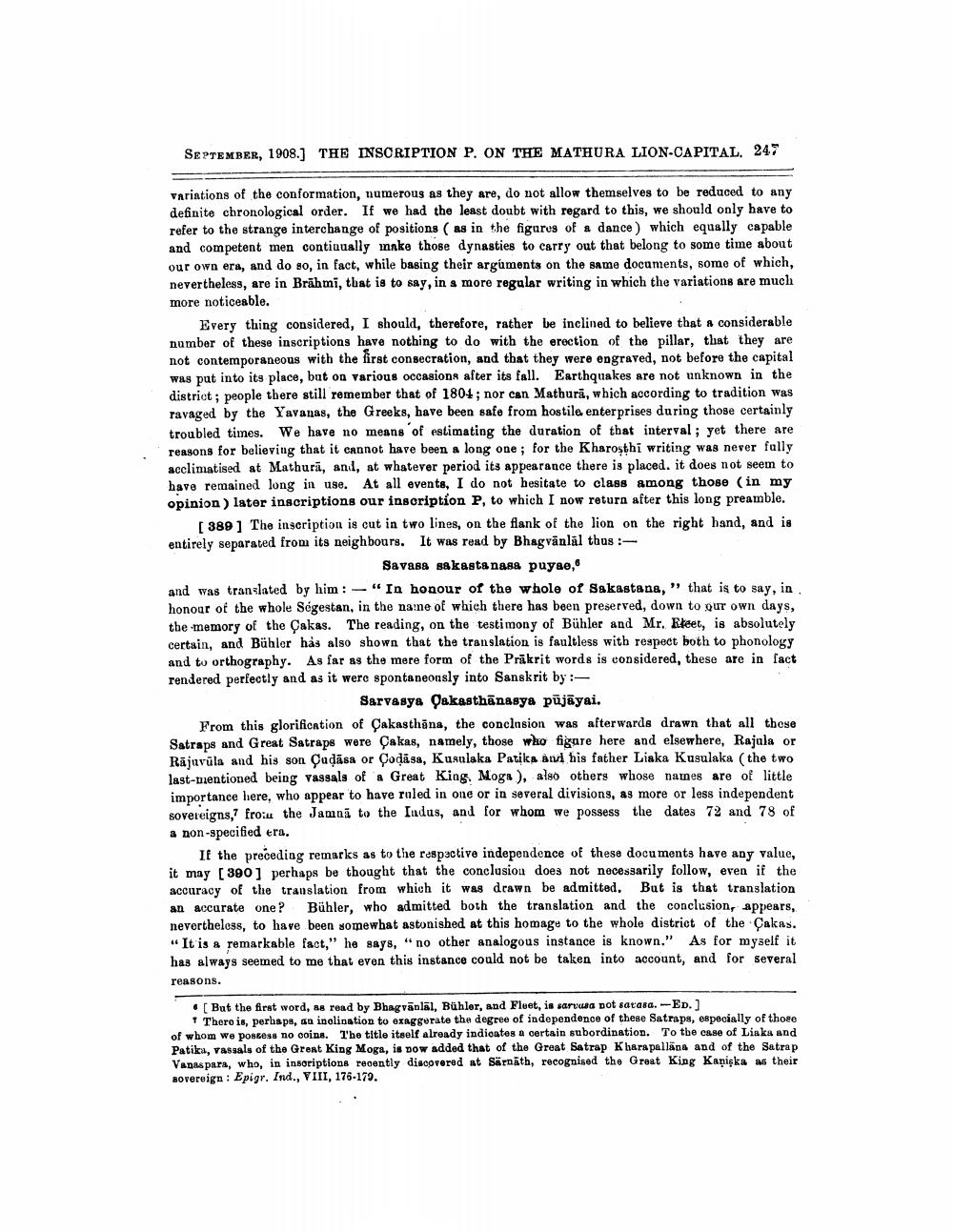________________
SEPTEMBER, 1908.] THE INSCRIPTION P. ON THE MATHURA LION-CAPITAL. 247
variations of the conformation, numerous as they are, do not allow themselves to be reduced to any definite chronological order. If we had the least doubt with regard to this, we should only have to refer to the strange interchange of positions (as in the figurus of a dance) which equally capable and competent men continually make those dynasties to carry out that belong to some time about our own era, and do so, in fact, while basing their arguments on the same documents, some of which, nevertheless, are in Brāhmi, that is to say, in a more regular writing in which the variations are much more noticeable.
Every thing considered, I should, therefore, rather be inclined to believe that a considerable number of these inscriptions have nothing to do with the erection of the pillar, that they are not contemporaneous with the first consecration, and that they were engraved, not before the capital was put into its place, but on various occasions after its fall. Earthquakes are not unknown in the district; people there still remember that of 1804; nor can Mathuri, which according to tradition was ravaged by the Yavanas, the Greeks, have been safe from hostile enterprises during those certainly troubled times. We have no means of estimating the duration of that interval; yet there are reasons for believing that it cannot have been a long one ; for the Kharosthi writing was never fully acclimatised at Mathuri, and, at whatever period its appearance there is placed. it does not seem to have remained long in use. At all events, I do not hesitate to class among those (in my opinion ) later inscriptions our inscription P, to which I now return after this long preamble.
[389] The inscription is cut in two lines, on the flank of the lion on the right hand, and is entirely separated from its neighbours. It was read by Bhagvanlal thus :
Savass sakasta nasa puyao, and was translated by him: - "In honour of the whole of Sakastana," that is to say, in honour of the whole Ségestan, in the name of which there has been preserved, down to our own days, the memory of the Cakas. The reading, on the testimony of Bühler and Mr. Eteet, is absolutely certain, and Bühler has also shown that the translation is faultless with respect both to phonology and to orthography. As far as the mere form of the Prākrit words is considered, these are in fact rendered perfectly and as it were spontaneously into Sanskrit by :
Sarvasya Pakasthānasya pūjāyai. From this glorification of Cakasthāna, the conclusion was afterwards drawn that all these Satraps and Great Satraps were Çakas, namely, those who figure here and elsewhere, Rajula or Rājavula and his son Çadāsa or Çodāsa, Kusulaka Patika and his father Liaka Kusulaka (the two last-mentioned being vassals of a Great King. Moga ), also others whose names are of little importance here, who appear to have ruled in one or in several divisions, as more or less independent sovereigns, frou the Jamni to the Iadus, and for whom we possess the dates 72 and 78 of a non-specified tra.
If the preceding remarks as to the respective independence of these documents have any value, it may [390] perhaps be thought that the conclusion does not necessarily follow, even if the accuracy of the translation from which it was drawn be admitted. But is that translation an accurate one? Bühler, who admitted both the translation and the conclusion, appears, nevertheless, to have been somewhat astonished at this homage to the whole district of the Cakas. "It is a remarkable fact," he says, " no other analogous instance is known." As for myself it has always seemed to me that even this instance could not be taken into account, and for several reasons.
• [ But the first word, as rond by Bhagvānlal, Bühler, and Fluet, is saruwa not satana. Ed.]
+ There is, perhaps, ao inclination to exaggerate the degree of independence of these Satraps, especially of thoeo of whom we postess no coine. T'he title itself already indicates a certain subordination. To the case of Liaka and Patika, vassals of the Great King Moga, is now added that of the Great Satrap Kharapallana and of the Satrap Vanaspara, who, in insoriptions recently discovered at Särnáth, recognised the Great King Kaniqka me their sovereign : Epigr. Ind., VIII, 176-179.




